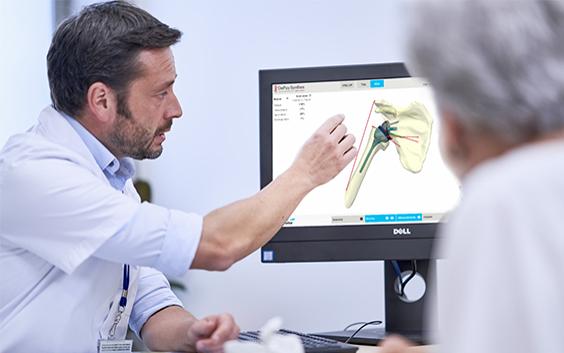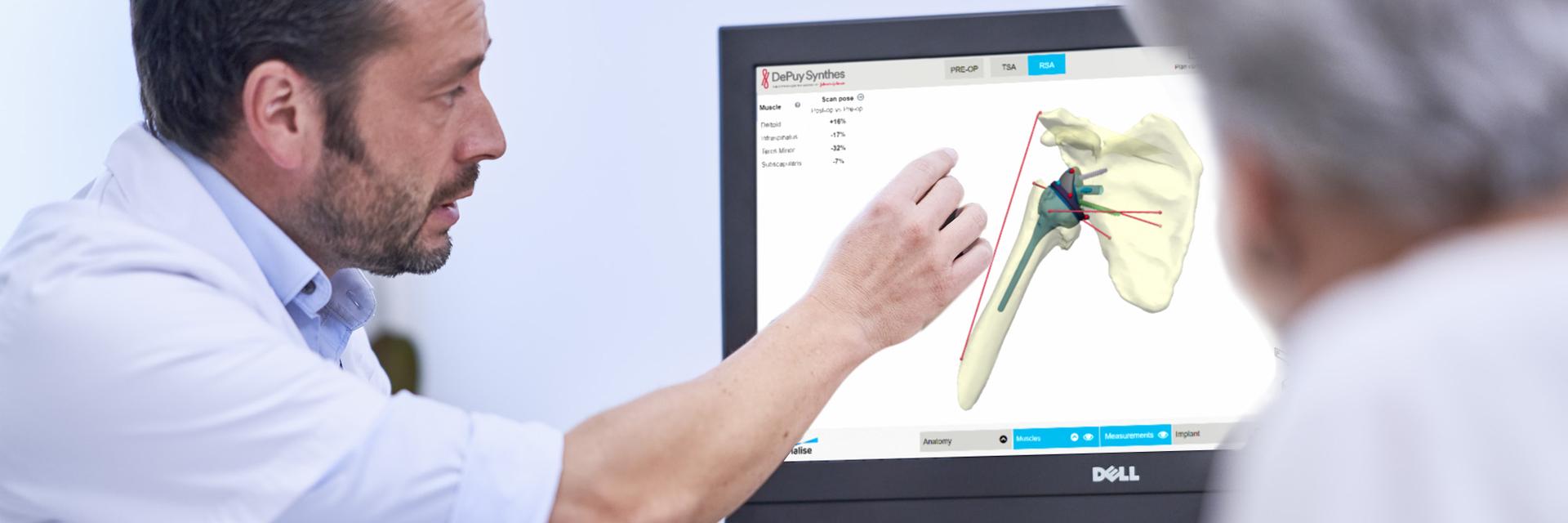EXPERT INSIGHT
Mimicking the Shoulder Joint’s Dynamic Nature with Muscle Simulation

By now, you have probably heard it said that personalization is the future of healthcare. In fact, the orthopaedics field is already turning digital to enable the transformation to mass personalization. More and more implant systems are becoming integral to a digital ecosystem, allowing you to track surgical planning and outcome data.
From the moment we started visualizing the anatomy in 3D, we saw problems in a new light, including things that would be impossible to find in 2D. This was a milestone in personalized healthcare because it offered the possibility to start planning based on precise information and significantly improve the predictability of patient outcomes.
Leading the way with predictable surgical planning, Materialise has already touched the lives of more than five million patients worldwide. Now, we’re creating the next milestone for personalized orthopaedics: 4D surgical planning.
The fourth D: dynamics
As every orthopaedic surgeon knows, a joint is not static, but a complex, dynamic system in which hard and soft tissue work together to allow us to move.
Through simulation of the shoulder joint’s dynamic nature, we believe the digitization of surgeries will elevate your understanding of the complex human anatomy and render shoulder replacements more successful for every patient.
Musculoskeletal modeling software (MSM) has been available for years but was limited to academic research because of the software’s complexity. At Materialise, we’re aiming to make this type of software more accessible to introduce it to daily clinical practice in support of mass personalization. In order to provide personalized care on a mass scale, we see three requirements:
- Enhanced predictability
- Intuitive, high-powered software
- A better understanding of muscle elongations on surgical outcomes
1. Enhanced predictability
Knowledge of the position of the glenohumeral rotational center and the muscle lengths is essential to understand the optimal placement of a total shoulder prosthesis to avoid complications such as:
- Instability problems and limited range of motion due to insufficient muscle tension (2 – 5% incidence)3
- Scapula fractures due to excessive tensioning of the deltoid (1 – 7% incidence)2,3,4
- Neurological injury due to excessive lengthening of the arm (~1% incidence)3
In combination with our existing Range of Motion (ROM) tool, this unique simulation for muscle elongation further enhances predictability. During digital planning, the two create powerful insights into the lengthening of the deltoid, infraspinatus, teres minor, and subscapularis muscles.


2. Intuitive and high-powered software
Compared to complex modeling software used in academic research, these intuitive and widely accessible tools will revolutionize clinical practice, enabling you to easily evaluate shoulder dynamics in your arthroplasties.
By levering artificial intelligence technology, the muscle simulation is entirely automated and allows an accurate and objective comparison of muscle elongations for different implants, positions, and patient anatomies.2


3. A better understanding of muscle elongations on surgical outcomes
The current academic literature on shoulder muscle elongations provides only limited guidance. In summary, it suggests that shoulder joint function and stability can be improved by lengthening the deltoid between 10% and 20%.1,5 Furthermore, excessive scapular strain, which may cause scapular fractures, can be prevented by limiting deltoid lengthening to less than 25mm.6
However, this is mostly based on cadaveric labs or mere computer simulations. Improving accessibility to powerful simulation tools enables broad data analysis to further investigate and understand the impact of muscle elongations on postoperative outcomes for real patients.
Mass personalization, the future is near!
Materialise launched a groundbreaking tool in our shoulder planner that mimics the shoulder’s dynamic traits. This unique simulation aims to enhance the predictability of shoulder replacements.
The moment we could visualize anatomy in 3D sparked a new milestone for personalized healthcare. And this powerful yet intuitive and widely accessible simulation for joint dynamics further adds to the momentum of mass personalization.
L-103216-01
- De Wilde et al, Consequences of deltoid muscle elongation on deltoid muscle performance: a computerized study, Clinical Biomechanics (17), 2002, 499-505
- Pitocchi et al, Automated muscle elongation measurement during reverse shoulder arthroplasty planning, J Shoulder Elbow Surg (30), 2021, 561–571
- Bohsali et al, Current Concepts Review – Complications of Shoulder Arthroplasty, J of Bone & Joint Surgery (99), 2017, 256 – 269
- Lädermann et al, Arm lengthening after reverse shoulder arthroplasty: a review, International Orthopaedics (38), 2014, 991–1000
- Roche et al, Impact of inferior glenoid tilt, humeral retroversion, bone grafting and design parameters on muscle length and deltoid wrapping in RSA, Bulletin of the Hospital for Joint Diseases (71), 2013, 284-293
- Shah et al, Influence of implant design and parasagittal acromial morphology on acromial and scapular spine strain after RSA, J Shoulder Elbow Surg (29), 2020, 2395-2405
Share on:
You might also like
Never miss a story like this. Get curated content delivered straight to your inbox.
